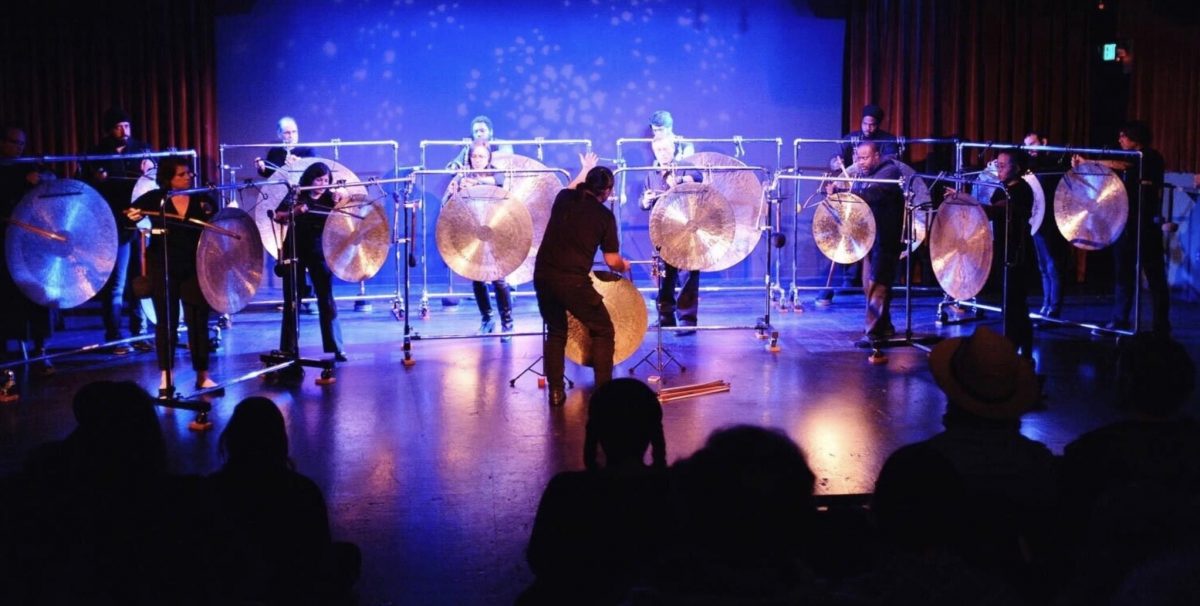As if Truth or Consequences, New Mexico, wasn’t notable enough due to its name, a Japanese composer and musician based there, who’s taught master classes far and wide, is making the burgh the world’s center of musical innovation. And this coming Sunday, Tatsuya Nakatani will bring that innovation to Memphis. But he needs the help of Memphians to do it. For he’s not only re-imagining sound, he’s re-imagining how musical ensembles are created.
For a few weeks now, followers of Goner Records’ social media have been responding to requests for volunteer gong-bowers. It’s not in everyone’s skill set, to be sure, but it may be in yours without you even knowing it. To bow a gong, and tune in to the layered vibrations that emerge, can be a very intuitive thing. And that’s what local volunteers for the Nakatani Gong Orchestra are finding as they prepare for a November 13th concert at Off the Walls Arts, at 8 p.m.
To find out a few more details about what promises to be one of the most remarkable performances in recent memory, I chatted with Nakatani about the ins and outs of gong-bowing.
Memphis Flyer: How does it work, as you tour through towns and recruit local players? Are you looking for any skills in particular?
Tatsuya Nakatani: Yes and no. Playing a gong is a difficult thing to do. Hitting a gong with a mallet is quite easy, but bowing a gong, the player has to have a real sense of it. So I don’t know until the day of the show how many people can do it. Sometimes, an experienced musician can handle it well, but sometimes not. It’s very difficult to explain this! One player I worked with was a yoga teacher, and she could play so well, because you need to feel the vibration of the gong growing, and bow on top of it. So it’s quite different from a usual musical instrument, compared to pressing a button or bowing a concert bass or cello or violin. It’s similar, but it’s unique.
So it’s not dependent on musical training, but more on a certain musical sensitivity?
Yeah, exactly. Sensitivity. Musical training is helpful, but I’m asking people to play together as a kind of string instrument. So five or six gongs playing together is kind of like five or six violins or cellos playing together.
How many players do you usually use?
Currently on this tour, I ask for 14. And usually the local curator manage the players. So I don’t deal with who’s playing and who’s not playing.
So you show up that morning, and rehearse for the show that night?
Yeah. There’s a training video you can watch on my website, about how to bow the gong, hear the vibration and follow my conducting. So they are trained by video. And the day of the workshop, we have two or three hours to rehearse. And then we perform that evening.
Is it all gongs, or is there other percussion?
No, it’s only gongs.
How do you lead them through a compostion? Do you have some kind of graphic score?
I prepare a score for myself. I memorize each gong’s vibrations and then compose from there. And then I hand conduct. Once the players understand how to read my hand signs, I can freely improvise as well. It’s based on the group. Some venues have different acoustics and frequencies, so I change the composition. I have to manage between the composition and improvisation.
So you alter the score for each performance, in each location?
Yeah.
Do you rely on your recruited players to improvise?
Yes, in a way, but mostly I’m improvising. And they are just trying to play their best. Someone recently said the orchestra is like a gigantic synthesizer, and each person is a kind of module, and I’m operating the modules [laughs]. So it’s a very large scale synthesizer, making vibrations.
I bet it’s a pretty eerie sound, with all those bowed gongs.
Yeah, it’s eerie, but also there’s more than just sound. There are lots of vibrations. In music, people focus on the sound, the melody and harmony, but there are also these secret vibrations. Combining the formation of the vibrations, and orchestrating the vibrations is really interesting. The vibrations merge and shift.
So the vibrations between the gongs are more like a felt thing?
Yeah, exactly. You probably can’t even record it. This is a live sound project. It’s 14 gongs, and with me there are 15. And the 15 gongs together are like a gigantic metal speaker system, and that projects vibrations and waves in a different way than conventional music.
Who have your influences been in creating this?
There’s no particular person who influenced me. I have been playing solo percussion since the ’90s, and I started bowing cymbals and gongs, and started thinking, ‘What about eight or ten people bowing?’ Just multiplying and dividing numbers of players. I knew a gong orchestra could work very early on. And then I started making bows to do my project, out of wood. There is no conventional bow for bowing percussion, so I needed to have some specific tools, so I started building them some time ago, before I started the Gong Orchestra. This project has been going 13 or 14 years now. I’ve done close to 200 shows.
